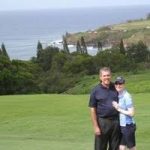What is your best advice to overcome nerves on the first tee?
Jitters on the first tee; EMBRACE IT!
I’ve been fortunate enough in my lifetime to play in six PGA Championships, ranging from 2002 to 2019. I have made it to the weekend in two of those times but most importantly I have hit the first tee ball in the first group off the first hole in 2013 and 2019 to open each championship so I have a little experience in handling nerves, excitement, and adrenaline.
Here is the skinny on first tee jitters. Your body is in a heightened state of adrenaline at this time and you have two options: 1. To be prepared and embrace the situation understanding that your body is in this heightened state and embrace it OR 2. To be scared and think something bad is going to happen. I prefer the number one! As your body gets nervous your breathing gets very shallow and short which cuts off your oxygen flow to your brain and heart. This causes your body to shake and become uncomfortable sometimes resulting in negative thoughts.
Let me tell you, you are what you think. If you think something terrible or embarrassing is going to happen, guess what, it will. But if you focus on embracing your nerves (and believe me EVERYONE gets nervous) and envisioning the best possible outcome it has a MUCH BETTER chance of coming true. The best way to calm your nerves and get rid of the shaking is to oxygenate your body by taking slow, deep, BELLY breaths, not CHEST breaths for a few minutes before you strike that shot. Breathe in through your nose and out of your mouth. This process will get the oxygen flowing through your blood brain barrier and into your lungs and heart relieving some of those jitters. This takes practice as everything does but in time will help give you your desired result.
And remember, see the ball in your mind flying farther and straighter than you have ever hit it before. With you being in this heightened state with the adrenaline flowing you will be surprised how far the ball will go. Oh yes, one more thing since you are in this heightened state your 100% is really 150% so a slower swing will do more for you than you think. If you follow the above steps, I promise you it will work like it has for me throughout my golfing career.
Play well, have fun and enjoy the best game on the planet. I hope to cross paths with you at some point and if you do please stop me to say hello as I’m always happy to help you with any golf questions that you may have!! Here’s to ripping it off the first tee and lowering your scores! Cheers!
Prepare well, Play well!
The first tee! Prepare to have a good start and play well!
How to prepare for the first tee jitters
The opening drive off the first tee in a round is an interesting experience that only golfers can understand. It can be the most humbling, or the most satisfying event in a day, a week or a career, depending on the situation, the event, or the audience.
I share one of the goals of everyone who plays the game. That goal is to confidently pure the tee shot on the opening hole, and enjoy that proud moment and a wonderful walk down the middle of the first fairway!
We should not leave the outcome of this shot for chance, biorhythms, star alignment, or your higher power, (She or He has more important issues to deal with!)) Let’s get busy preparing to be more relaxed, more focused, comfortable and confident when facing this defining moment. There are no guarantees, but you can help yourself to consistently have a better experience by preparing for it.
There are a couple of different approaches to “loosening up” and preparing for the round. Some players head to the driving range and others go upstairs and head to the bar!
We recommend the first option. If you do, then the bar can be the place to go for a post-round celebration and sharing stories of “shots of the day” with friends.
I have played with, observed and polled a lot of great players over the years, and they all agree that simply preparing well, taking a good deep breath, and having a good routine is the best way to turn first tee jitters into positive expectations, confidence, and better performance.
Let’s start with the fact that the great Jack Nicklaus once said that he always gets a little nervous stepping up to the first tee, regardless of the circumstances or magnitude of the event. He said “preparation is the key!”
“When you prepare well and execute a solid tee shot, the reward and satisfaction are well worth the time and effort to prepare properly.”
In general, good preparation involves :
1: Arriving at the course with enough time to warm up comfortably, without rushing!
2: Have a set warm-up routine that includes starting with short shots and working your way up to longer and more challenging clubs.
3: Promote confidence by finding good lies to hit off of, or hit a few off a tee. Nothing promotes confidence and calm better than feeling some solid strikes.
4: Try to simulate how you are going to step up and drive off the tee. The more times you are in that situation, and the more you commit and stick to your routine, the more relaxed and comfortable you will become. Finish your warm-up with a good drive! (even if you have some range balls left, leave them, and have a nice leisurely walk to the tee with the feeling of that last shot. This is a good image and feeling to focus on repeating!
5: Be aware and try to time your approach to the tee area so you are comfortable and timely. Neither rushed or there too early, with too much time to dwell or see others fail. Be in charge of your situation!
6: Enjoy the challenge! It’s part of the game. Learn from each experience and what it takes for YOU to perform your best.
Be aware that everyone who has played the game has had a misstep or two off the first tee. We all understand the mistakes and appreciate the good shots. The poor shots give the good ones greater value!
Lastly, trial, error, and experience are your best teachers. If you have an inner desire to play well, you will figure out what it takes for you to do your best, as long as you are having fun and continue trying!!!!!
Go well!
Bob K
Really want to improve your golf game? Get incredible swing tips delivered to your inbox every week.
Overcome "fear" not nerves
You can’t “overcome” nerves on the first tee if “overcome” means shut down your body from the normal heightened state of awareness (what some call “nerves”) that every golfer should have on the first tee. You can eliminate “fear” on the first tee using four approaches.
1. Before you go to the first tee, practice the first tee shot on the range. Visualize it. Gain some confidence in what you plan to do on the first tee and if you cannot be confident with a driver or even a three wood or driving iron, hit something you can be relative confident in.
2. Stop thinking you and the first tee shot is important and you are being judged by others more on that shot than any other shot. It is of equal value to every other shot, including tapping in that putt that hangs on the edge of the hole.
3. Plan your shot for the fat part of the fairway or better side of the fairway and pick the tightest, smallest target possible, preferably a 3 yard square target at the largest to land your tee shot.
4. This is the most important – swing smooth, only 70% max and do not seek to impress anyone, do not hit is as far as you can, and do not try to alter your normal shot. If you usually draw the ball, go with that shot.
It's Just a Game
I’ll answer this one in two parts.
First, nerves are a sign that you care. If you weren’t a little nervous, I’d wonder why you’re even playing the game. Calm the nerves by doing something you’ve done thousands of times before – your pre-shot routine. If you don’t have one, DEVELOP one! If you’ve heard “focus on the process,” that’s what this gives you: something to focus on that you’ve done thousands of times before.
Second, and this isn’t for everyone or in all situations… tell yourself that in the grand scheme of things, whether you shoot the best or worst score you could possibly shoot that day, your life probably won’t change all that much. You’ll still have your family, your friends, your job… You’ll feel good or bad for a few days, but overall, the sun still comes up in the east tomorrow.
Prepared
Being prepared is the best and easiest way to calm your nerves so you feel good about your first swing of the day.
Having a little bit of nerves is a good thing; it means you care and you’re wanting to play well. But being too nervous or having no nervousness at all is a sign you’re not prepared, nor do you care.
Prepare the night before, envisioning the shot and how you intend to play that shot. You can also envision how the ball flight will look and where it will land. Prepare at the practice area as you get ready to play, by rehearsing the first tee shot. Go through your pre-shot routine and make the swing. Finally, if you do have a little nervous energy on the tee, take a deep breath. You’ll be surprised how putting an extra burst of oxygen in your system will calm you.
Take just a little time to prepare to play your first shot. Doing so will set up a great round of golf.
Acknowledge those 1st Tee Jitters
The best way to overcome nerves is with the same strategy you would implore in a negotiation.
Step 1: Acknowledge the feelings/thoughts and gain awareness. Say to yourself “I know I am nervous and I sense how this is making me feel”.
Step 2: Make the feelings ok and reassure yourself. It is okay to be nervous because you care about this situation. “It’s okay to be nervous because I care and want to get off to a good start”.
Step 3: Change course (refocus) and move the feelings to the appropriate place. “For me to get off to a good start, let’s pick my target, visualize my shot, and focus on my breathing”.
I often hear people chastise themselves for getting nervous or focus too much on the nerves themselves. Let’s not empower the nerves but acknowledge and respect why they are there. It’s because you care about what you are doing. Make that okay and then acknowledge, reassure and refocus to help deal with those 1st tee jitters.
Positivity
Remember one of the best first tee shots you’ve ever hit, and focus on it for 15 seconds before teeing off. Visualize it in slow-motion. Poor first tee shots tend to follow a poor mindset – worry, fear, anxiety, whatever. Change it by focusing on something positive.
The Best Defense against Nerves
The best defense against nerves anywhere on the course is a great pre-shot routine. With our young students at the U.S. Kids Academy we say; “Plan, Set-up, & Play” To help them develop a repetitive routine. The “Plan” includes picking the target, then picking the club based on distance, wind and deciding if it’s up hill or down hill. The “Set Up” starts with aiming the train at the target (the ball flies or rolls down one rail while the feet stand on the other rail) then grip, set up, and posture. “Play” begins with the letter Y (arms & club) either swinging back and through the same distance or turning the Y into an L for longer distances. Mastering a routine is THE requirement for our students to pass Level 5 in our 10 Level curriculum. If we can teach a 6 year old the Plan, Set Up & Play routine….you can learn it too.
Visualizing the range back home
Practice visualizing the first tee when you are practicing on the driving range back home. Look at your favorite target on the range, look at the ball, and picture yourself shaping your shot to the target. When your ready to hit the ball on the first tee (any tee for that matter) Line up and make your final adjustments, close your eyes and visualize your favorite spot at your range back home. When you open your eyes only look at the ball, Replay in your head that shot on the range shaping your ball to the target. Only after you look up will you be pleasantly surprised to see your ball going down the fairway.
Golf Drill to shake the 1st tee nerves
The best way to avoid nervous on the 1st tee is preparation. A drill for this is playing a round of golf on the driving range with a particular golf course in mind. This would mean changing clubs for the appropriate hole (Par 3,4,5). Then visualizing that particular hole and a target. This will help the player relax more and help them be more confident.
Nerves are Natural, embrace them.
Being nervous on the first tee is natural for the athlete who is passionate. Nerves mean your care. Controlling your feelings is essential. And enjoying the moment is a must. The best way to control your nerves is to realize that you are in charge of every golf shot that you play. Do not try to push away or overcome your feelings, embrace them. Trust yourself. Smile and always be excited for your event. Besides, you prepared yourself, right?
Here’s a great tip to help you control your state of mind. Before reporting to the first tee for your assigned starting time, conclude your driving range warm up with five drives. Put yourself, mentally, in the moment, by practicing your pre-shot routine, including visualization and your practice swing. Pretend you are hitting your first shot of the day. Then, do it again, methodically, mentally and physically, four more times. Smile. Take deep breaths. Focus on the target. Imagine it is your teetime. And most importantly, have fun. Be happy, feel confidence and trust your ability to prepare yourself.
Breathing/Visualization
First Tee nerves tend to hit most people. You want to get off to a good start, you don’t want to do something to embarrass yourself and you feel it is a positive way to get things going.
There are a couple of good things you can do. First try and work on your breathing, slow deep breaths. You want to try and slow things down and do your best to try and relax.
The second thing you can do is try visualization. Most people tend to play the same course or same courses. You also tend to have favorite holes, ones that you tend to play well and you usually hit good Tee shots. As you are standing on the first tee visualize that you are playing your favorite hole. Picture the quality shots that you have hit on that hole and then try and duplicate that on your current tee shot.

Five Ponds Golf Club | Flagler Golf Academy, Warminster, PA
Embrace Those Nerves, Come Prepared!
It doesn’t matter whether it’s the first hole with your buddies or the first hole of the Ryder Cup, everyone has nerves. What we do with those nerves can have a big impact on not only the first tee but a good chunk of the round. The best way to make sure that you’re ready for the first tee and everything it comes with comes down to preparation. It’s not just hitting balls to get loose or having your first beer, it comes down to being ready for it, and that happens well before you’ve even arrived at the course.
What I do to prepare myself for the first tee is mental rehearsals. Now this may seem silly or a waste of time, but it really does work. Whether I am playing in a tournament or just going out for a quick nine, I always mentally rehearse that first tee shot. I will close my eyes and mentally put myself on that first tee. I see the layout of the hole in my mind. I create the wind and my surrounding environment. I go through my reshot routine and then I see myself making the swing and watching the ball fly exactly how I want it to go.
By doing these mental rehearsals before arriving to the first tee, this will help calm your nerves a bit because you have gone through this situation many times before. As you go through your rehearsals create different environments as well. Add a lot of wind to the equation, or throw in a little rain. Try and create as many different scenarios as you feel like. All this will do is better prepare yourself for anything that may happen.
This practice really should only take a couple of minutes. The more detailed you get the more you will be ready come time to pull the trigger. Your nerves will be a bit calmer because you have already seen yourself hit the shot and all you need to do is go through your motions and get the round started on the right foot!

Glen Oak Golf Course, East Amherst, NY
Nervous? Where's your attention?
The first thing when feeling nervous is to understand that nerves are natural. I like to say if you’re not nervous, you’re not ready! Second, nerves are just excess energy and normally dissipate on their own. Simply having this awareness alone, paired with the understanding that nerves aren’t something to fret about, can help many players.
However, if a player is nervous to the point he can’t even step foot on the first tee, generally that player needs to redirect his attention. Being nervous normally stems from directing one’s attention on a RESULT. For example, a player who is teeing it up with his boss may be nervous because he is afraid of hitting a bad shot and making double-bogey on the first hole. While such thinking seems logical, the problem is that the player can’t actually control the RESULT of how his tee shot ends up or what score he ultimately makes on the hole. A better strategy is for the player to redirect his attention on what he can fully control, such as the PROCESS of hitting the tee shot. Directing attention on executing the best PROCESS possible (hole strategy, club selection, pre-shot routine, execution, post-shot routine) and accepting whatever RESULT occurs, will normally yield a better outcome anyway. And, the added benefit is if the player directs his attention on the PROCESS of what he needs to do, his attention won’t be on a hypothetical RESULT, thereby eliminating the stressor causing the nervousness.
Take-home message: Nerves are natural. When you’re overly nervous, redirect your attention on what you can control (PROCESS) and have acceptance of whatever outcome (RESULT) follows. If you do, the nerves will dissipate on their own, and you’ll find yourself in an improved mental state to play your best!
How to overcome nerves on the first tee.
Many swing flaws in golf are rooted in tension experienced by the body. Typically, this tension is a result of performance anxiety stemming from an overactive mind. The abundance of thoughts interferes with our breathing patterns and ability to focus. Anytime we experience stress on the course, such as first tee jitters, it triggers a “fight or flight” response which disrupts our breathing resulting in a loss of blood flow to the extremities and to the brain. Most golfers are not aware of their breathing patterns. It’s important to practice and develop diaphragmatic breathing daily. Incorporating deep breathing into your pre-shot routine will calm your mind and increase your sense of rhythm and tempo. You might be surprised the next time you walk up to the first tee with a different state of mind, perhaps a Zen-like state. 🙂
Calm Yourself with a Ball Toss
First tee jitters are a good thing. It means you are engaged and you care about the adventure you are about to experience. Embrace it! Nervousness and excitement are the same emotion. Sometimes it gets a bit overwhelming, especially when you can feel your heartbeat. This means your mind is “racing” and you need a reboot! When I need to settle down a bit I employ a technique I learned from the legendary “Little Pro”, Eddie Merrins. Simply toss your golf ball up and down gently. Focus your eyes intently on the ball as you toss it up and catch it. This focus will calm you down. When it’s your turn to play, stay in your normal routine and pick a very definitive target and go have some fun!
Embrace the Challenge
Often in this case people fear nerves, it is important to understand them and give them some respect! I let our players know and for myself, embrace the nerves, trying to ignore doesnt work. Say, hello, recognize why you are feeling this way, then let yourself know that this is what your have done all the work for. It is ok to be nervous but not scared. If you are scared, it is likely you have not prepared for the moment. With this being said, BREATHE, run in place burn some energy, then go into control breathing and visualization as to what you are wanting to accomplish. Let it go!!
Preparation is Key!
I always found that if I put in the time and the effort to prepare for the event I always did better on the first tee. I would also remind myself that this shot carries no more weight than any of the other shot I would hit that day. They all count 1. Is it important to start the round off well? You bet. The first shot should not make or break a round. There are plenty of shots left to hit. But it is nice to start the round off well!
You're Going to Be Nervous
Well I asked this to a 18 time major champ when I caddie for him in Florida and he told me you are going to be that way. But for myself in tournaments or qualifying I would take a deep breath and release slowly. Then have positive self talk about the shot at hand.
No substitute for a good pre-shot routine
Pre-shot routine needs to be practiced too, but when you feel comfortable and confident it works, your first tee shot has a greater chance of being successful. Nerves are normal, don’t fight them.
A Routine for the First Tee Jitters
In an ocean of nerves and negative first tee feelings, you need a liferaft to get you through the choppy waters. This liferaft is a routine that consists of a methodical warm up session combined with a well thought out pre-shot routine. Let’s begin with arriving at the golf course. Give yourself plenty of time to check in, use the locker room, and get something to eat. You certainly don’t want to feel rushed if you don’t have to. Next start with putting, chipping, and pitching. This will give you a sense of how you feel with a club in your hand, and allows you to get familiar with the green speed, weather, and your swing tempo.
From there, move over to the driving range and work your way up through the bag from the wedge up to the driver. Ensure that the last club you hit on the driving range is the club that you will use on the first tee. From there, let’s rely on the well groomed pre-shot routine. At this point, your pre-shot routine should be second nature. Concentrating on the pre-shot routine takes your mind off any nerves from the first tee. If you don’t have a pre-shot routine, here is a simple one you can use or modify.
First, take a practice swing from behind the golf ball. Look for something (piece of discolored grass, dirt patch, divot, etc.) in front of your golf ball that allows you to find a target line. Then stand perpendicular with this line and address the golf ball. Now here’s the secret- look down at your target line and give yourself a little waggle with the club. Once your eyes comes back down to the golf ball, you must start your swing. This keeps you fluid and doesn’t allow your mind to get hung up on anything but the swing. The act of the eyes returning back to the golf ball puts you in a reactive mode, relying on your practice and muscle memory. If you give yourself a chance to think about anything else, nerves creep in.
In summary, be reactive on the first tee box. Focus on a good pre-shot routine, and give yourself enough time to get familiar with the environment. I know you’ll hit more fairways in no time!
Practice and a Game Plan
I think all golfers from beginners to tour players all have some nerves on the first tee. The best way to conquer those nerves and fears is to have a Practice tee session prior to getting to the first tee. Hit at least 20 full shots or enough to understand what your ball flight will be for the day. Then visualize the first hole and the shot that best fits your swing for the day to have the best result. Try to hit that first tee shot on the range with your last two balls. If the first one is good and what you hope for then move to the first tee.
I also think it is important that golfers understand that all golfers have first tee nerves and most other golfers around the first tee are not really paying as much attention to you as you likely think. But a brief practice session with a clear game plan for your first tee shot will help with the nerves.
Enjoy the Challenge
The first tee nerves aren’t a bad thing they just mean you care. If you learn to focus on what your’re trying to do and not on all the trouble. Once you start to master this it becomes fun to embrace the challenge and enjoy succeeding under pressure.
It's just another shot!
Figure out where you want to hit it, what kind of shot you want to hit, and go through your pre-shot routine if you have one. If you don’t have one…get one. Focusing on what you need to do will clear out most of the “noise” and reduce anxiety. You also might focus on taking the club away a little extra slow to avoid the “Zorro” first hole takeaway. Remember…it’s just another shot. You are about to have a few hours of fun.
1st Tee Jitters
If you do not have your nerves jumping on the 1st tee you probably are not entirely ready to play! The key to handling your nerves is to redirect the nervousness into focus on the shot at hand. Pick your target and swing to it. Too many times I see players get onto the tee and think about topping the ball or hitting into the trees or water. Also the mind is racing from any or all bad tee shots you have played this year. You just have to block that out and that will help you to get past the nerves. Take a deep breath think about the shot then step in and swing the club. You will be amazed at how well you will do.
Nervous or Excitement
When we get nervous – golf swings get shorter and faster. On the first tee – try making the biggest slowest swing possible
Reminds of a story – Gary Player once asked Jack Nicklaus if he got nervous before a big tournament or one first tee. Jack responded I do not get nervous – I get excited – I am excited to perform and show off all my hard work in getting ready for the tournament
If you aren't nervous on the first tee you don't care
I’ll never forget watching an interview with Tiger Woods when he was asked if he still gets nervous playing golf. He immediately responded “If you are not nervous on the first tee you don’t care.” He went on to say he hopes he never loses that feeling because he then would know his time is up. If arguably the best player of all time is nervous it’s safe to say the rest of us will be too. While there is no way to completely eliminate nerves experience helps as well as a positive warm up session. Pick the shot you are going to hit off the first tee and hit it on the range a couple of time to get as comfortable as possible. Sick to what you know works and trust it. The first swing of the day doesn’t have to be a driver. If you are more comfortable with your 3 wood go with it. Getting off to a positive start with a shot in the fairway should always be the goal!
Have a consistent pre-shot routine
I would say the best way to overcome nerves on the first tee is to have a consistent pre-shot routine. This will not only help you overcome the first tee nerves, but any nerves you will have throughout your round. This helps to relieve tension during your setup, and help you feel confident before you make your swing.
A little butterflies are good!
Being a little nervous is usually good, it helps you concentrate & perform better.
Take a deep breath, “see” your shot in your mind & take your swing.
Trust it, you will do fine!
1st Tee Nerves
It affects everyone to some degree, if it didn’t, something is wrong with you LOL… It probably comes down to confidence. If you are confident in your ability to hit a great shot, you will tend to enjoy the opportunity on stage. If you’re not, and have doubts – you’ll need to do all those things that the guru’s preach about breathing, focus, etc. and you will probably try NOT to hit a poor shot… that in and of itself makes things difficult. ENJOY THE MOMENT AND THE CHALLENGE!

Mohegan Sun Golf Club, Baltic, CT
Find a comfort zone!!!
As a PGA PROFESSIONAL and a successful player…this is a difficult task. Any advice I give should be digested carefully. Think of positive experiences, playing great rounds, your best tee shot ever, or even the prettiest girl you ever kissed! If you immerse yourself in this, your jitters will recede. Pick the best club to get you into good position. Then aim for the center of the green, and putt to the corners. You might make birdie, or in a good case, start out with par and start great momentum!!!!
First Tee Jitters
Very common to experience the “First Tee Jitters”, everyone does! The best way to deal with them is to rely on your pre-shot routine and trust the swing. You really have to learn to detach yourself from “outcome” and focus on “process”. Work through your routine, and learn to let it go. We really can’t control the outcome very well, but we can control the process of routine and trusting it. Learn to enjoy the first tee jitters and hit some bombs off the tee!
only the positives
It is hard to teach positive thinking, but everyone can act to overcome jitters . A dress rehearsal on the practice tee of envisioning being on the first tee and the shot you are about to hit will help. Do it several times. Chewing gum may also relax you. Look how many greats chew gum. Just before you hit any shot, show a little smile or grin. You’d be surprised how these two extra tips will help. There is no room for any negative thoughts to enter your train of thought or you will get nervous. Fear of failure always ends poorly.
Who is stronger you are golf.
Every time you tee it golf is a challenge on who will win, golf or you. Not by score but mentally are you tougher than golf. If you have first tee jitters than sorry you have already lost. If you let it it will beat the crap out of you. If you are frustrated or discouraged during golf then you are losing the battle. If you are scared over a 3 footer then you are losing the battle. If you keep head high and take every punch the game gives you lake a man then you have a chance to win.
Fooling myself
I always try to end my warm-up as if I’m finishing out on the second or third hole. I just walk over to the first tee like its just another hole in the middle of the round.
Know YOUR Basics
A player must have a simple, basic swing concept so that under pressure, when the mind almost goes blank, they have something simple and uncomplicated to focus on. For me, it’s start in balance, stay in balance, and nail the finishing position. By keeping it simple, the brain has something do-able to focus on, preventing it from interfering with too many thoughts or distractions. Trusting this will increase the probability of a good result.
Go through your complete routine
Practice hitting the shot required on the range before arriving to the first tee. Do not leave practice range until you have a clear picture and have performed the shot several times. When you arrive at the tee go through your complete routine.
Breathe and use a routine
Best way to tackle nerves and hammer your first tee shot? First, take a deep breath and exhale slowly intentionally lowering your heart beat and making it easier to focus. Next have and use your pre-shot routine just like any other shot. This will help your mind stay on the task of hitting a solid tee shot. Use the adrenaline you feel to focus on the target. It’ll make hitting that first fairway even more exciting. Tom Colceri PGA
Say "Relax" then Swing Away!
Say relax to yourself then swing away!
Accept and Get On With It
For me the first thing I do when feeling nervous is to accept it. Trying to ignore how I’m feeling doesn’t work for me. I accept my nervous energy and then move to getting focused. Also, the more I think ahead the more nervous I get. I say: accept what you feel, stay present, be yourself, and realize it is just a golf shot.
































